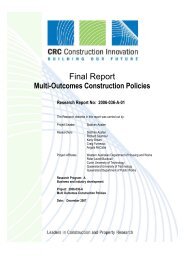Sustainable subdivisions - Construction Innovation
Sustainable subdivisions - Construction Innovation
Sustainable subdivisions - Construction Innovation
- No tags were found...
Create successful ePaper yourself
Turn your PDF publications into a flip-book with our unique Google optimized e-Paper software.
RainwaterThe Australian Bureau of Statistics (2005) reports that17% of homes have rainwater tanks installed for allhousehold water end uses. However, most of thesetanks are installed in rural areas. In urban areas, theaesthetic form and physical size of a tank are criticalfactors for selection, rather than capacity to providereliable supply. The many designs in the market range insize, shape, fabrication material, collection system andtreatment technology to be appropriate for various lotsizes, dwelling types and end-user needs.Rainwater systems involve collection, storage,treatment and distribution technologies. The three maintypes of collection systems are:• dry systems (the most common type) — all pipesare above ground• wet systems — collection pipes are buried toreduce aesthetic impact and pipes contain aresidual volume of water• siphonic systems — the collection system isdesigned to maximise pipe fl ow rates usingsiphonic full bore fl ow.Collection systems employ gutter guards, fi rstflush diverters and inlet fi lters to reduce ingress ofcontaminants such as leaves, animal faecal matterand airborne pollutants. Gardner et al. (2004) foundfi rst-fl ush devices reduced rainwater tank contaminantlevels at the cost of collection effi ciency. Althoughthe use of fi rst-fl ush devices is frequently advocatedby manufacturers and in guidance notes, statisticallyrelevant data showing their relative contaminantremovaleffi ciency or improvement in stored waterquality is lacking.Distribution of rainwater is usually via a pump, althoughin certain situations, end uses can be gravity fed. Ifmains water is used as a back-up supply, it is notrecommended to top up the tank, as the mains waterloses potential energy when supplied to the tank andthen has to be repumped to required end uses(Gardner et al. 2006). An automatic diverter device, inwhich mains water pressure is used when mains waterback-up is required, is more effi cient in terms of energyuse.Treatment of rainwater depends on the intended enduse and three main types are used: fi ltration, thermaldisinfection and ultraviolet (UV) treatment. Filtrationprovides a barrier to micro-organisms and both microandultra-fi ltration are used. Thermal disinfection usingthe hot water service is currently being investigated,and results have shown that bacteria do die off attemperatures relevant to domestic hot water systems.None of the treatment processes provide residualdisinfection, and all have associated maintenance andreplacement requirements.Householder awareness of what is in their rainwatertank is important so that usage can be adjustedaccordingly and also so they know when mains waterback-up is being used. A number of innovative fl oatsystems are available to monitor tank water level, andsome can be retrofi tted to existing tanks.Mains water savings due to the installation of raintankswill be dependent primarily on the volume and timingof runoff into and out of the raintank. This meansthat factors affecting the savings will include: climate,collection area, tank size, water usage, irrigationrequirements and end uses of the rainwater.Rainwater collection system — 60L8
















